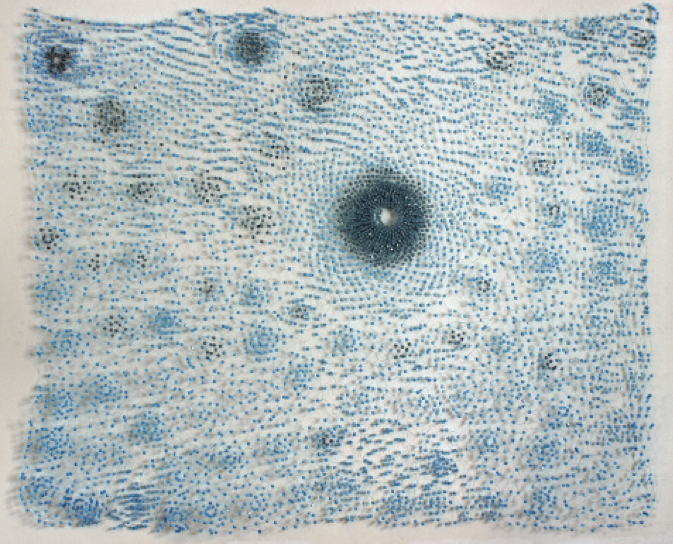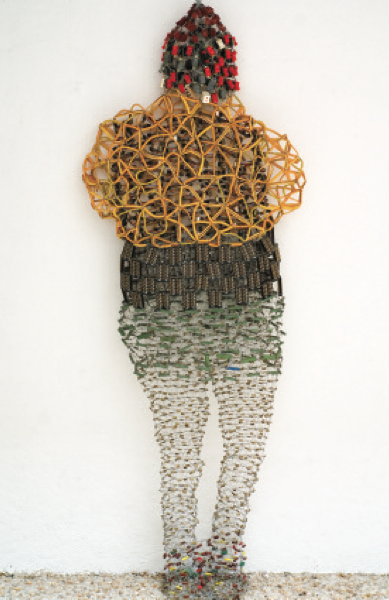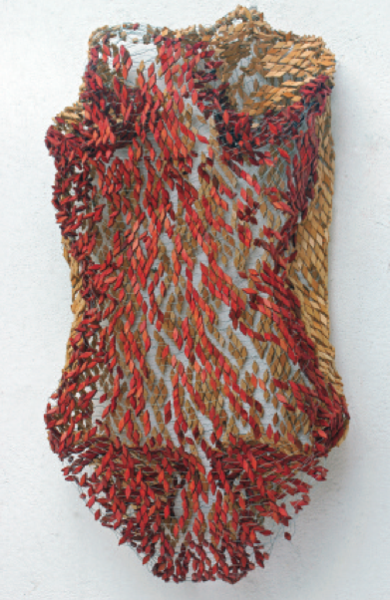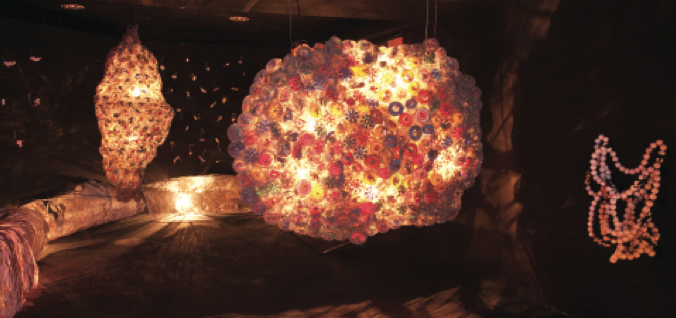Luiz Hermano
Found and Lost
When I asked Luiz Hermano what he thinks about while weaving his complex threads of wire that bind together all sorts of prosaic objects, his answer was that he meditates. Meditation can be practiced at various different levels, ranging from concentrating on a shape to being at one with the cosmos. What station on the extensive dial of meditation does he tune into to spend hours and hours embroidering his pieces? Meditation, I realized after comparing his answer to his oeuvre, also involves playing with time and challenging finitude.
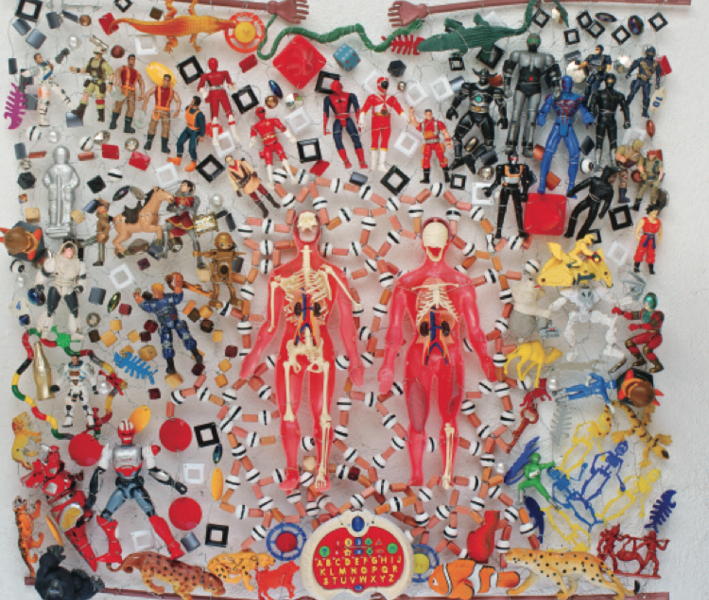
A collector of everyday objects, Hermano also collects time, the underlying structure that sustains the universe, that transparent substance in which we live immersed. Thus, he weaves and bundles together plastic toys, electrical capacitors, beads and threads of time: now time has no way of fleeing or disguising itself in a scant timeline. While Hermano weaves time, his pieces take on formats that cannot be dissociated from cosmological matters. Céu (Sky), a piece that the artist completed recently, is a large and complex web resembling a clear, starry night. Blue beads of various shades are positioned on the elaborate grid, scattered or clustered in circles of different sizes. The large scale of the work and the shine of the beads hint at the primordial philosophical inquiry of star gazing.
The subject of the origins or meaning of the world has followed Luiz Hermano since the 1970s, when he produced watercolours, etchings and paintings populated by fanciful beings and myths from different cultures, ranging from Noah’s Ark to the turtle that in Indian tradition carries the universe on its back. Centaurs, flying elephants, half-fish half-man Hieronymus Bosch-like beings populate the stories Hermano created with watercolours or, when there was a shortage of artistic media, percolated coffee. Metal engraving, a time-consuming technique prone to the development of fanciful narratives, also played an important role in Hermano’s earlier production. Both the etchings and the copper matrix are stored in his studio together with the fantastical watercolours, while he has focused on sculptural works for the last twenty years. In 1991, the São Paulo Biennial set aside a room for his sculptures in braided wood veneer laminate, generating mysterious objects enhanced by dramatic lighting and shadows in line with the denseness of Hermano’s cosmological themes. Some of these wooden strip sculptures, like Figura (Figure), from 1998, resemble the shapes of the sacred objects of candomblé, like those introduced to the world of contemporary art by Mestre Didi. In Hermano’s work, however, there is no defined religiousness, or indeed any invocation of the transcendental. His wound layers of wooden strips seem to affirm precisely that this here, and only this, is what exists, this finite world full of objects that can be combined in numerous ways, tied, braided, displaced, resulting in another object which, being new, wants to overcome finitude. Dealing with time and finitude, Hermano seems to put into practice Friedrich Nietzsche’s theory of the eternal return: the world is finite, occurring in an infinite time. Hence, repetitions are inevitable. How can one escape the feeling of annihilation caused by the hypothesis of a world which is only this, without any transcendental heaven? By insisting on creating the new, born of the recombining and displacement of finite elements of this world. Luiz Hermano’s Heaven is made of blue, plastic beads, and of the meditative capture of time – infinite time.
Escaping the finite and limited has been a speciality of Hermano’s since his childhood in the interior of Ceará state, in the northeast of Brazil. Building toys with animal bones or making up stories about the origins of the ranch where he lived, Hermano created in order to escape. When he left his town, he studied philosophy until abandoning the course to travel around Latin America, learning the stories and traditions of other peoples. Nowadays, Luiz Hermano travels every year across several combinations of latitude and longitude on the grid that maps the Earth.
In Thailand, in India and in China, he found Buddha statues in age-old buildings, erected in accordance with sacred geometry, and was enchanted by the mandalas which map out the universe. But he also wandered the streets bustling with the trade of plastic bits and bobs, fake toys, computers of a somewhat suspicious origin. The sacred entangled with the profane. So, around 2006, he built large mandalas and heavenly horses by entangling wire and power capacitors. Sometimes resembling cocoons or sarcophagi, these sculptures insist on posing questions about creation and finitude. Power capacitors – stocks of energy – also appear in brain-shaped works Hermano entitled Memória (Memory) and Berçário (Nursery). How are inventions born? And what about this incredible and mysterious machine called the brain? Was it created when time and chance played together? Toys are key elements in understanding Hermano’s thinking. A child playing alone with a few objects enters a state of suspension as if nothing else existed, a moment of pure construction of imagined worlds that, as stated by Winnicott, constitutes an intermediary area of experimentation. This intermediary zone would be a third part of a human being’s life, in addition to the internal psychic reality and the outer, shared reality. The porosity of Hermano’s pieces – the web is also a collection of holes – ontributes to this reading of his work as associated to Winnicott’s theories of the intermediate zone, the large area between subjectivity and objectivity, and its relation to the transitional object, the first object a baby elects to be a thing separate from him or herself, but which he or she possesses and controls. The first frustration experienced by a baby is realizing that the mother’s breast as it exists in the outer reality is not the same breast as the baby deemed to possess and be able to control, that is, the introjected breast. The intermediary area is a transitional zone which allows for the creation of illusions that bridge these two ideas of the maternal breast and which becomes, as the child grows, the territory of religion, art and creative scientific work.1 Cultural experience is in fact an extension of the play developed in the intermediary area.
In his work Clínica (Clinic), Hermano ties together various toys, heroes and animals. At the centre of this agglomeration, two halves of a plastic model of the human body are attached to the wire structure. Interestingly, the two halves do not match, forbidding the desire of closing them together to form a whole. The spectator can see the entrails and bones of these bodies and all the other objects. If we turn the work around to exhibit its other side, we are no longer able to see this nucleus of bodies. Likewise, the other toys will turn their backs on the spectator. Clínica, therefore, can be read as a membrane that gives access simultaneously to the internal world – represented by the entrails and bones – and the external world — the cultural field, represented by all the other objects.
The capacity of objects to connect illusion (subjective representation of the world) and the common reality is also presented in the series Falso Brilhante (Fake Stone), in which Luiz Hermano exalts brazen counterfeiting, raising it to the level of sincere lying. One of these giant adornments is Banda Larga (Broadband), a simple mesh made of silver coloured chain links, the name of which reveals its relationship to the artist’s 2007 works, which referred more explicitly to technology. Beads, we can agree, have always been connected to the idea of transcendental communication. When holding a rosary in his hands and reciting Hail Marys and The Lord’s Prayer, the Catholic is following a code of conduct for communicating with the saints, via broadband data transmission which begins by logging in with the sign of the cross. Religion, consumerism, and technology merge in the beads of the Falso Brilhante series. Playing means developing a healthy and reassuring illusion. Making bead jewellery is child’s play. Microelectronics accounts for the everyday lives of adults connected to high-tech toys such as mobile phones and computers.
No wonder Luiz Hermano meditates while making his pieces. He enters a state of mind similar to that of the child playing, and while tuning the movement of his hands to the frequency of his brain waves, he erects an area where the illusion of being at one with the universe is integrated with the consciousness of being separated from that same universe. In the meshes created by Hermano – as in the sacred architecture he found in ancient cultures – the illusion of being able to control and map out the universe by building things coexists well with the frustration of being a finite entity in a universe that exists in infinite time. One of his works from 1999 summarizes Hermano’s project of building transitional spaces to overcome this primordial frustration: Todas as Mulheres do Mundo II (All the women of the world II), which has copper tying together several cabaças, a Brazilian fruit that resembles a breast.

